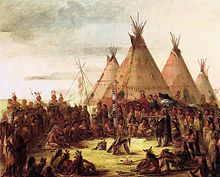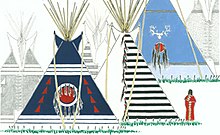Типи
Типи (енгл. tipi / teepee/tepee[1]) шатор је у облику конуса (купе), који се традиционално прави развлачењем животињске коже о дрвене штапове. Модерни типији обично имају платнени покров.[2] Типи се разликује од осталих конусних шатора по димним отворима на врху структуре.[3][4][5] Историјски, типи су користили аутохтони становници (Преријски Индијанци) Великих прерија и Канадских прерија у Северној Америци. Још увек их користе у овим заједницама, мада у последње време примарно за обредне сврхе уместо свакодневне употребе за живљење. Сличан објекат, лаву, користи народ Сами у северној Европи.[6][7][8]




Типији се често стереотипски и нетачно повезују са свим Америчким домороцима у САД и аутохтоним народима у Канади, без обзира на то што се исти користе искључиво код народа из ’Прерија’.[9] Племена Америчких домородаца и владе Првих нација из других региона користили су другачије објекте за становање.[2][нап. 1] Типи је дуговечан,[10] пружа топлоту и комфорт зими,[11] хладан је у врела лета,[нап. 2] те сув током јаких киша.[12][13] Типији могу да се раставе и спакују брзо и лако у случају потребе релоцирања; исто тако, склапају се без потешкоћа на новом месту где су премештени.[14][15][нап. 3] Оваква мобилност је кроз историју била важна Преријским Индијанцима у њиховом повремено номадском стилу живота.[16]
Види још
уредиНапомене
уреди- ^ Morgan, Lewis H. N. A. Ethnology. iv:115. »I have seen it in use among seven or eight Dakota sub-tribes, among the Iowas, Otoes, and Pawnees, and among the Black-feet, Crows, Assiniboines, and Crees. In 1878, I saw it in use among the Utes of Colorado. A collection of fifty of these tents, which would accommodate five hundred persons, make a picturesque appearance. Under the name of the "Sibley tent" it is now in use, with some modifications of plan, in the United States Army, for service on the plains.« [Сибли шатор има један штап у центру и ниједан отвор за одвођење дима из централног ложишта.]
- ^ Уз подигнуте стране. В.:
- Anthropological papers. стр. 211. 1917.
- ^ Луис Х. Морган бележи да у Дакоти своје кожнате шаторе зову ви-ка-јо. Дат је одломак његовог текста...
- N. A. Ethnology. iv:114. »When first discovered the Dakotas lived in houses constructed with a frame of poles and covered with bark, each of which was large enough for several families. They dwelt principally in villages in their original area on the head-waters of the Mississippi, the present State of Minnesota. Forced upon the plains by an advancing white population, but after they had become possessed of horses, they invented a skin tent eminently adapted to their present nomadic condition. It is superior to any other in use among the American aborigines from its roominess, its portable character, and the facility with which it can be erected and struck. "[...]" When the tent is struck, the poles are attached to a horse, half on each side, like thills, secured to the horse's neck at one end, and the other dragging on the ground. The skin-covering and other camp-equipage are packed upon other horses and even upon their dogs, and are thus transported from place to place on the plains. This tent is so well adapted to their mode of life that it has spread far and wide among the Indian tribes of the prairie region.«
Референце
уреди- ^ Teepee, or tepee, en.wiktionary.org; teepee. www.dict.org; tepee (dwelling) -- Encyclopædia Britannica
- ^ а б Laubin, Reginald; Laubin, Gladys (2012). The Indian Tipi: Its History, Construction, and Use (2 изд.). University of Oklahoma Press. ISBN 978-0806188522.
- ^ Holley, Linda A. Tipis-Tepees-Teepees: History and Design of the Cloth Tipi.
- ^ Denison Peet, Stephen; ур. The American Antiquarian and Oriental Journal. 24:253.
- ^ Washington Kingsbury, George (1915). History of Dakota Territory. S.J. Clarke Publishing Company. 1:147.
- ^ Olden, Sarah Emilia (1918). The People of Tipi Sapa (the Dakotas): Tipi Sapa Mitaoyate Kin. Morehouse Publishing Company. стр. 25.
- ^ Guide to the museum, first floor. Museum of the American Indian; Heye Foundation. стр. 105. 1922.
- ^ Geological Survey Professional Paper. U.S. Government Printing Office. 670:21. 1969.
- ^ National Museum of the American Indian (2007). Do All Indians Live in Tipis?. New York: HarperCollins. ISBN 978-0-06-115301-3.
- ^ Annual Reports. 17(1):405. 1898.
- ^ „Shelter”. Anthropological Papers of the American Museum of Natural History. 5—6:115. 1910.
- ^ Yue, David; Yue, Charlotte (1984). The tipi: a center of native American life. стр. 15.
- ^ Shields, George O.; Rand, McNally (1890). Camping and Camp Outfits: A Manual of Instruction for Young and Old Sportsmen. стр. 43.
- ^ Dellenbaugh, Frederick Samuel (1900). The North-Americans of yesterday. G.P. Putnam's Sons. стр. 204.
- ^ Morgan, Lewis H. „Houses and House Life of the American Aborigines”. N. A. Ethnology. iv:114.
- ^ Wissler, Clark (1920). North American Indians of the Plains. American Museum of Natural History.
Литература
уреди- Laubin, Reginald; Laubin, Gladys (2012). The Indian Tipi: Its History, Construction, and Use (2 изд.). University of Oklahoma Press. ISBN 978-0806188522.
Спољашње везе
уреди- Историја, конструкциха и еволуција типија + слике и цртежи (језик: енглески)
- Simply Differently.org: Tipi, извор о прављењу типија, приручници и онлајн калкулатор за држаче покрова (језик: енглески)
- Tipi Instructions, PDF документ са информацијама о градњи типија (језик: енглески)